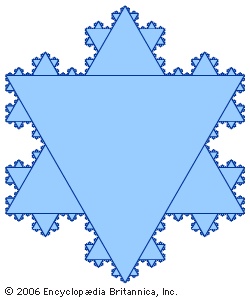Koch, Niels Fabian Helge von
Swedish mathematician
born January 25, 1870, Stockholm, Sweden
died March 11, 1924, Stockholm
 Swedish mathematician famous for his discovery of the von Koch snowflake curve, a continuous curve important in the study of fractal geometry.
Swedish mathematician famous for his discovery of the von Koch snowflake curve, a continuous curve important in the study of fractal geometry.Von Koch was a student of Gösta Mittag-Leffler and succeeded him as professor of mathematics at Stockholm University in 1911. His first work was on the theory of determinants of infinite matrices (matrix), a topic initiated by the French mathematician Henri Poincaré (Poincaré, Henri). This work now forms part of the theory of linear operators, which are fundamental in the study of quantum mechanics. He also worked on the Riemann hypothesis (see Riemann zeta function) and the prime number theorem.
Von Koch is remembered primarily, however, for a 1906 paper in which he gave a very attractive description of a continuous curve that never has a tangent. Continuous, “nowhere differentiable (differentiation)” functions had been rigorously introduced into mathematics by the German Karl Weierstrass (Weierstrass, Karl) in the 1870s, following suggestions by the German Bernhard Riemann (Riemann, Bernhard) and, even earlier, by the Bohemian Bernhard Bolzano (Bolzano, Bernhard), whose work was not well known. Von Koch's example is perhaps the simplest. Starting with an equilateral triangle, it replaces the middle third of each segment with an equilateral triangle having the deleted portion of the segment as its base (the base is erased). This replacement operation is continued indefinitely, with the result that the limiting curve is continuous but nowhere differentiable. If the new triangles always face outward, the resulting curve will have a striking resemblance to a snowflake, and so the curve is often called von Koch's snowflake.
- shawm
- Shawnee
- Shawneetown
- Shaw, Norman
- Shawn, Ted
- Shawn, William
- Shawqī, Aḥmad
- Shaw, Robert
- Shaw, Sir Napier
- Shaw, Wilbur
- Shay, Ephraim
- Shaykh Aḥmad Sirhindī
- Shaykh Junayd
- Shaykh Khalīfa ibn Hạmad al- Thāni
- Shaykh Ḥaydar
- Shays, Daniel
- Shays's Rebellion
- Shazar, Zalman
- Shaʿnabī, Mount Ash-
- Shaʿrānī, ash-
- shaṭḥ
- Shaṭṭ Al-ʿ Arab
- Shaṭṭārīyah
- Shcharansky, Anatoly
- Shchepkin, Mikhail Semenovich